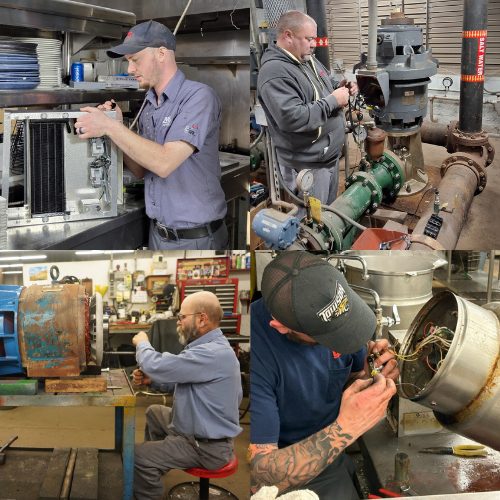Prepare your HVAC for the summer heat!

Baltimore tech, Bill Kidd, seen here changing the air filters on the EMR Headquarters rooftop HVAC units.
Summer is a time when your HVAC system will be working overtime. Much like we don’t drive our vehicles without an oil change or routine service, preparing an HVAC system for the heat is critical. By properly maintaining the system, you can save money, reduce energy consumption, and create a comfortable environment for employees and guests.
Although some maintenance tasks should be restricted to professionals, here are a few that are quite simple and straightforward to handle in-house as you prep for the summer season.
Schedule preventative maintenance.
Commercial HVAC systems are a critical part of any type of business. Schedule a regular preventive maintenance (PM) program to extend the life of your unit(s). Units are often on the roof and therefore out of sight, out of mind. Have your service agent handle the PM scheduling for you on a regular, timed basis making it one less thing to worry about. Finding a PM plan that works for your budget and your facility can go a long way!
Clean outdoor areas.
Debris that has built up around your air conditioning unit negatively impacts airflow and the overall efficiency of the system, which can force your unit to use more energy to perform the same job. Any loose debris like leaves and sticks should be removed to ensure proper efficiency. You can also brush away and hose off dirt and dust that has built up on the fans and grates in your unit.
Change the air filters regularly.
Clean air filters can extend the life of your HVAC system. As a general rule, a business in a relatively clean environment, such as an office building, should replace or clean its HVAC filters on a quarterly basis. However, HVAC filters should be changed once a month in factories, restaurants, auto shops and other businesses that have heavy machinery, chemicals, grease, oil, dust and debris. If this is overlooked, filters lose their ability to remove pollutants from the air and can cause system failure.
Inspect and maintain the thermostats.
It’s easy for operators to forget that thermostats need regular testing to make sure they’re working properly. Before the peak of the summer heat hits, confirm the thermostat temperature matches the room temperature. You can achieve this by checking the room temperature with a thermometer and compare it to the reading on the thermostat. If there is a discrepancy, you may need to recalibrate the unit or call in a professional to diagnose a potentially bigger, underlying issue.
Turn on the unit and let it run.
Lastly, and the most simple task of all, turn on your HVAC unit! You’ll want to do this test in the spring on a pleasant day. Don’t wait until the weather is blazing hot to turn on your air conditioning for the first time, only to find it is not working properly. Give yourself some margin! Finding and addressing an issue early can save you money and uncomfortable, irritated staff and clientele.




